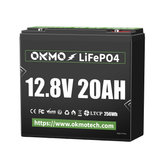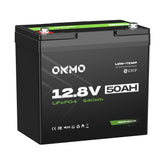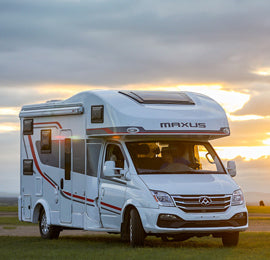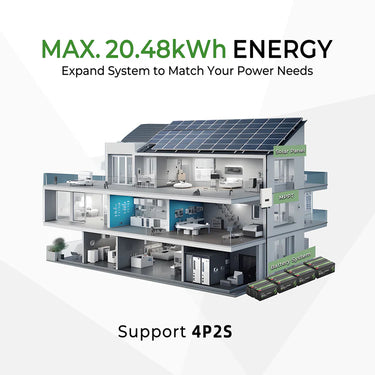DIY Home Energy Storage System : Practical Guide & Advanced Discussion

Part 1: Re-evaluating "Solar Battery Price" and DIY Value
Your OKMO batteries come with a built-in BMS, meaning the solar battery price of $739.99 you paid already includes intelligent management and protection functions for each unit. This significantly reduces the complexity and peripheral component costs of the DIY project.
Your investment of $8,879.88 buys you not just a collection of cells, but 12 ready-to-use, intelligent battery units with built-in overcharge, over-discharge, overcurrent, and short-circuit protection. This enhances the safety and operability of the project, allowing the DIY enthusiast to focus more on system integration rather than underlying cell management.
 Part 2: Optimized DIY Tutorial (For Batteries with Built-in BMS)
Part 2: Optimized DIY Tutorial (For Batteries with Built-in BMS)
Core Concept: Since each battery has its own BMS, we cannot install a "master BMS" for the entire battery bank, as it would conflict with the internal BMS. Our task is to safely combine them into a large system.
Step 1: System Planning and Design (The Constant that Changes)
-
Voltage Scheme (Still Highly Recommended: 48V System): Connect 4 batteries in series to form one 48V 400Ah battery module. With 12 batteries, you can form exactly 3 such modules.
-
Connection Method: Connect these 3 sets of 48V 400Ah battery modules in parallel to form the final system: 48V, 1200Ah, 57.6 kWh.
Step 2: Required Parts List (Key Adjustments)
-
Inverter/Charger All-in-One (Unchanged): Still a hybrid inverter with 48V input.
-
DC Circuit Breakers/Fuses (Even More Critical): It is essential to install an independent DC circuit breaker on the positive output of each 48V battery module. This is the lifeline for isolation, maintenance, and safe parallel operation.
-
Battery Cables and Copper Busbars (Unchanged): High-quality thick copper cables and busbars.
-
Battery Rack/Enclosure (Unchanged): Sturdy, well-ventilated rack.
-
Battery Balancer/Active Voltage Equalizer (Core New Addition!): This is the key to success! Because the 3 battery modules operate independently, their BMS units cannot communicate with each other. This leads to voltage inconsistencies, especially near the top and bottom of charge/discharge, causing some modules to cut off early and reducing overall usable capacity. You need a Battery Balancer or Active Voltage Equalizer. It connects via thin wires to the main positive and negative of each battery module and automatically transfers energy from higher-voltage modules to lower-voltage ones, achieving dynamic balance.
-
Advanced Option: If your inverter supports it (e.g., some Victron, SMA models), consider a third-party battery monitor which can monitor total current via a shunt and communicate with the inverter, but configuration is more complex. For most DIYers, a standalone balancer is the simplest and most effective solution.
-
 Step 3: Assembly Process (Precision Operation)
Step 3: Assembly Process (Precision Operation)
-
Initial Check and Pre-Charge:
-
Individually measure the voltage of each OKMO battery. Ensure all battery voltages are very close (e.g., all around 13.3V). Voltage consistency is the foundation of successful paralleling!
-
If voltages differ, it's recommended to first use a separate, low-current LiFePO4 charger to individually charge each battery to full (approx. 14.2V-14.6V, refer to OKMO manual), allowing their built-in BMS to perform a top balance.
-
-
Assemble Battery Modules:
-
Connect 4 batteries in series to form a 48V module. Use original or sufficiently thick connecting cables and ensure they are tight.
-
Note: No need to install an additional BMS at this stage; the batteries' built-in functions are active.
-
Repeat this process to complete the other 2 modules.
-
-
System Integration and Paralleling:
-
Place the 3 fully charged and voltage-matched 48V battery modules into the rack.
-
Install the Balancer: Connect its balance wires to the main positive and negative of each battery module according to its manual.
-
Create Parallel Busbars:
-
Use copper busbars to create a positive busbar and a negative busbar.
-
Connect each module's positive terminal -> its DC circuit breaker -> Positive Busbar.
-
Connect each module's negative terminal -> Negative Busbar.
-
-
Connect the Main Positive and Main Negative (from the busbars) to the inverter's DC input terminals via a Main DC Circuit Breaker.
-
-
Connection and Commissioning (Safety First):
-
Before initial power-on, ensure all DC circuit breakers are in the OFF position.
-
First, connect the inverter's AC output to the load panel (ensure the grid is disconnected).
-
Connect the inverter to the grid supply (mains).
-
Turn on each battery module's DC circuit breaker one by one, finally turn on the Main DC Circuit Breaker. Observe if the inverter recognizes the DC power source.
-
Let the system charge the entire battery bank via grid power. During this time, observe the voltage balance of the 3 modules via the balancer's indicators or screen.
-
After charging is complete, perform a load test. Once everything is normal, finally connect the solar panels.
-
 Part 3: Reassessing Practicality and Risk Warnings
Part 3: Reassessing Practicality and Risk Warnings
Advantages:
-
Simplified Design: No need to research complex external BMS wiring and configuration.
-
Modularity: If any single battery module fails, you can isolate it by disconnecting its breaker for maintenance without affecting the other two groups, offering excellent system maintainability.
Challenges & Risks:
-
Consistency Dependency: System performance highly depends on the consistency of the protection thresholds of each built-in BMS. Batteries from different batches may have slight variations.
-
"Bucket Effect" Capacity: During charging or discharging, the group whose voltage first reaches the protection threshold will be disconnected by its BMS first, causing the entire system to stop working even if other groups still have charge. This is why the balancer is so crucial.
-
Lack of Communication: Most built-in BMS cannot communicate with advanced inverters. Therefore, the inverter might not get an accurate "State of Charge (%)" and can only estimate it roughly based on voltage, which is less precise.
 Conclusion:
Conclusion:
Using OKMO batteries with built-in BMS for DIY is an excellent choice for users seeking high cost-performance and with some technical foundation. The solar battery price you paid grants out-of-the-box convenience and basic safety. The keys to success lie in meticulous initial preparation (voltage matching) and using a parallel balancer to compensate for the lack of system-level management.
This project will not only provide you with a powerful home energy station but also give you a deep understanding of the principles of distributed battery management systems. Wishing you a successful build!








